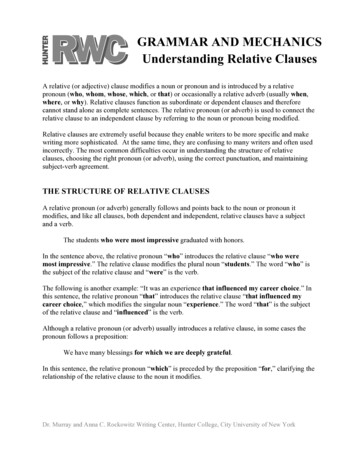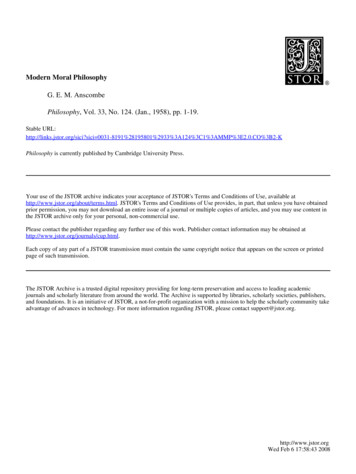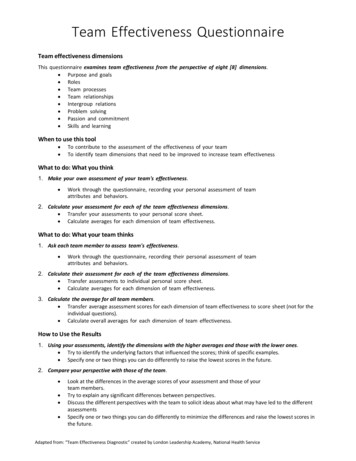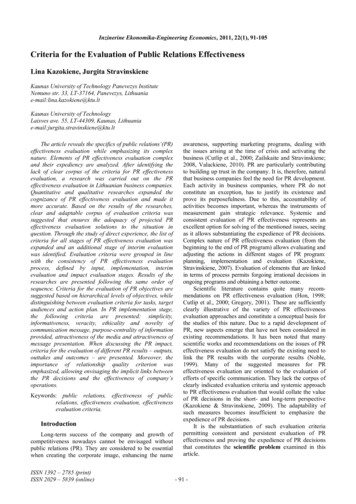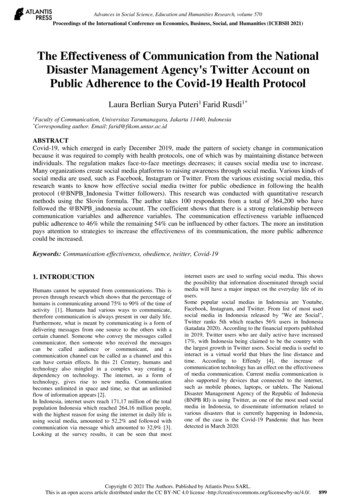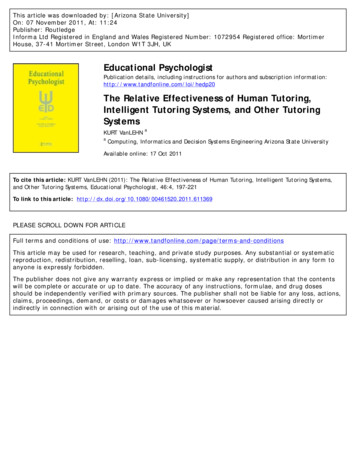
Transcription
This article was downloaded by: [Arizona State University]On: 07 November 2011, At: 11:24Publisher: RoutledgeInforma Ltd Registered in England and Wales Registered Number: 1072954 Registered office: MortimerHouse, 37-41 Mortimer Street, London W1T 3JH, UKEducational PsychologistPublication details, including instructions for authors and subscription he Relative Effectiveness of Human Tutoring,Intelligent Tutoring Systems, and Other TutoringSystemsKURT VanLEHNaaComputing, Informatics and Decision Systems Engineering Arizona State UniversityAvailable online: 17 Oct 2011To cite this article: KURT VanLEHN (2011): The Relative Effectiveness of Human Tutoring, Intelligent Tutoring Systems,and Other Tutoring Systems, Educational Psychologist, 46:4, 197-221To link to this article: SE SCROLL DOWN FOR ARTICLEFull terms and conditions of use: nsThis article may be used for research, teaching, and private study purposes. Any substantial or systematicreproduction, redistribution, reselling, loan, sub-licensing, systematic supply, or distribution in any form toanyone is expressly forbidden.The publisher does not give any warranty express or implied or make any representation that the contentswill be complete or accurate or up to date. The accuracy of any instructions, formulae, and drug dosesshould be independently verified with primary sources. The publisher shall not be liable for any loss, actions,claims, proceedings, demand, or costs or damages whatsoever or howsoever caused arising directly orindirectly in connection with or arising out of the use of this material.
Educational Psychologist, 46(4), 197–221, 2011C Division 15, American Psychological AssociationCopyright ISSN: 0046-1520 print / 1532-6985 onlineDOI: 10.1080/00461520.2011.611369The Relative Effectiveness of HumanTutoring, Intelligent Tutoring Systems, andOther Tutoring SystemsKurt VanLehnDownloaded by [Arizona State University] at 11:24 07 November 2011Computing, Informatics and Decision Systems EngineeringArizona State UniversityThis article is a review of experiments comparing the effectiveness of human tutoring, computer tutoring, and no tutoring. “No tutoring” refers to instruction that teaches the samecontent without tutoring. The computer tutoring systems were divided by their granularityof the user interface interaction into answer-based, step-based, and substep-based tutoringsystems. Most intelligent tutoring systems have step-based or substep-based granularities ofinteraction, whereas most other tutoring systems (often called CAI, CBT, or CAL systems)have answer-based user interfaces. It is widely believed as the granularity of tutoring decreases,the effectiveness increases. In particular, when compared to No tutoring, the effect sizes ofanswer-based tutoring systems, intelligent tutoring systems, and adult human tutors are believed to be d 0.3, 1.0, and 2.0 respectively. This review did not confirm these beliefs.Instead, it found that the effect size of human tutoring was much lower: d 0.79. Moreover,the effect size of intelligent tutoring systems was 0.76, so they are nearly as effective as humantutoring.From the earliest days of computers, researchers have strivedto develop computer tutors that are as effective as humantutors (S. G. Smith & Sherwood, 1976). This review is aprogress report. It compares computer tutors and human tutors for their impact on learning gains. In particular, thereview focuses on experiments that compared one type oftutoring to another while attempting to control all other variables, such as the content and duration of the instruction.The next few paragraphs define the major types of tutoring reviewed here, starting with human tutoring. Currentbeliefs about the relative effectiveness of the types of tutoring are then presented, followed by eight common explanations for these beliefs. Building on these theoretical points,the introduction ends by formulating a precise hypothesis,which is tested with meta-analytic methods in the body of thereview.Although there is a wide variety of activities encompassedby the term “human tutoring,” this article uses “human tutoring” to refer to an adult, subject-matter expert workingsynchronously with a single student. This excludes manyCorrespondence should be addressed to Kurt VanLehn, Computing, Informatics and Decision Systems Engineering, Arizona State University, POBox 878809, 699 South Mill Avenue, Tempe, AZ 85287-8809. E-mail:kurt.vanlehn@asu.eduother kinds of human tutoring, such as peer tutoring, crossage tutoring, asynchronous online tutoring (e.g., e-mail orforums), and problem-based learning where a “tutor” workswith small group of students. Perhaps the major reason whycomputer tutor developers have adopted adult, one-on-one,face-to-face tutoring as their gold standard is a widely heldbelief that such tutoring is an extremely effective method ofinstruction (e.g., Graesser, VanLehn, Rose, Jordan, & Harter,2001). Computer developers are not alone in their belief. Forinstance, parents sometimes make great sacrifices to hire aprivate tutor for their child.Even within this restricted definition of human tutoring,one could make distinctions. For instance, synchronous human tutoring includes face-to-face, audio-mediated, and textmediated instantaneous communication. Human tutoring canbe done as a supplement to the students’ classroom instruction or as a replacement (e.g., during home schooling). Tutoring can teach new content, or it can also be purely remedial. Because some of these distinctions are rather difficultto make precisely, this review allows “human tutoring” tocover all these subcategories. The only proviso is that thesevariables be controlled during evaluations. For instance, ifthe human tutoring is purely remedial, then the computer tutoring to which it is compared should be purely remedial aswell. In short, the human tutoring considered in this review
Downloaded by [Arizona State University] at 11:24 07 November 2011VANLEHNincludes all kinds of one-on-one, synchronous tutoring doneby an adult, subject-matter expert.In contrast to human tutoring, which is treated as onemonolithic type, two technological types of computer tutoring are traditionally distinguished. The first type is characterized by giving students immediate feedback and hints ontheir answers. For instance, when asked to solve a quadraticequation, the tutee works out the answer on scratch paper,enters the number, and is either congratulated or given ahint and asked to try again. This type of tutoring systemhas many traditional names, including Computer AidedInstruction (CAI), Computer-Based Instruction, ComputerAided Learning, and Computer-Based Training.The second type of computer tutoring is characterizedby giving students an electronic form, natural language dialogue, simulated instrument panel, or other user interfacethat allows them to enter the steps required for solving theproblem. For instance, when asked to solve a quadratic equation, the student might first select a method (e.g., completingthe square) from a menu; this causes a method-specific formto appear with blanks labeled “the coefficient of the linearterm,” “the square of half the coefficient of the linear term,”and so on. Alternatively, the student may be given a digitalcanvas to write intermediate calculations on, or have a dialogue with an agent that says, “Let’s solve this equation. Whatmethod should we use?” The point is only that the intermediate steps that are normally written on paper or enacted inthe real world are instead done where the tutoring system cansense and interpret them. The tutoring system gives feedbackand hints on each step. Some tutoring systems give feedbackand hints immediately, as each step is entered. Others waituntil the student has submitted a solution, then either mark individual steps as correct or incorrect or conduct a debriefing,which discusses individual steps with the student. Such tutoring systems are usually referred to as Intelligent TutoringSystems (ITS).A common belief among computer tutoring researchers isthat human tutoring has an effect size of d 2.0 relative toclassroom teaching without tutoring (Bloom, 1984; Corbett,2001; Evens & Michael, 2006; Graesser et al., 2001; VanLehnet al., 2007; Woolf, 2009). In contrast, CAI tends to producean effect size of d 0.31 (C. Kulik & Kulik, 1991). Althoughno meta-analyses of ITS currently exist, a widely cited review of several early ITS repeatedly found an average effectsize of d 1.0 (Anderson, Corbett, Koedinger, & Pelletier,1995). Figure 1 displays these beliefs as a graph of effect sizeversus type of tutoring. Many evaluations of ITS have beendone recently, so it is appropriate to examine the claims ofFigure 1.This article presents a review that extends several earliermeta-analyses of human and computer tutoring (Christmann& Badgett, 1997; Cohen, Kulik, & Kulik, 1982; FletcherFlinn & Gravatt, 1995; Fletcher, 2003; J. Kulik, Kulik, &Bangert-Drowns, 1985; J. Kulik, Kulik, & Cohen, 1980;J. A. Kulik, Bangert, & Williams, 1983; G. W. Ritter, Bar-2.52Effect size1981.510.50No tutoringCAIITSHumanFIGURE 1 Common belief about effect sizes of types of tutoring. Note. CAI Computer Aided-Instruction; ITS IntelligentTutoring Systems.nett, Denny, & Albin, 2009; Scruggs & Richter, 1985; Wasik,1998). All the preceding meta-analyses have compared justtwo types of instruction: with and without tutoring. Somemeta-analyses focused on computer instruction, and some focused on human instruction, but most meta-analyses focusedon just one type of tutoring. In contrast, this review comparesfive types of instruction: human tutoring, three types of computer tutoring, and no tutoring. The “no tutoring” methodcovers the same instructional content as the tutoring, typically with a combination of reading and problem solvingwithout feedback. Specific examples of no tutoring and othertypes of tutoring are presented later in the “Three IllustrativeStudies” section.THEORY: WHY SHOULD HUMAN TUTORINGBE SO EFFECTIVE?It is commonly believed that human tutors are more effectivethan computer tutors when both teach the same content, so fordevelopers of computer tutors, the key questions have alwaysbeen, What are human tutors doing that computer tutors arenot doing, and why does that cause them to be more effective?This section reviews some of the leading hypotheses.1. Detailed Diagnostic AssessmentsOne hypothesis is that human tutors infer an accurate, detailed model of the student’s competence and misunderstandings, and then they use this diagnostic assessment toadapt their tutoring to the needs of the individual student.This hypothesis has not fared well. Although human tutors usually know which correct knowledge componentstheir tutees had not yet mastered, the tutors rarely knowabout their tutees’ misconceptions, false beliefs, and buggyskills (M. T. H. Chi, Siler, & Jeong, 2004; Jeong, Siler, &Chi, 1997; Putnam, 1987). Moreover, human tutors rarelyask questions that could diagnose specific student miscon-
Downloaded by [Arizona State University] at 11:24 07 November 2011RELATIVE EFFECTIVENESS OF TUTORINGceptions (McArthur, Stasz, & Zmuidzinas, 1990; Putnam,1987). When human tutors were given mastery/nonmasteryinformation about their tutees, their behavior changed, andthey may become more effective (Wittwer, Nuckles, Landmann, & Renkl, 2010). However, they do not change their behavior or become more effective when they are given detaileddiagnostic information about their tutee’s misconceptions,bugs, and false beliefs (Sleeman, Kelly, Martinak, Ward, &Moore, 1989). Moreover, in one study, when human tutorssimply worked with the same student for an extended periodand could thus diagnosis their tutee’s strengths, weaknesses,preferences, and so on, they were not more effective thanwhen they rotated among tutees and thus never had much familiarity with their tutees (Siler, 2004). In short, human tutorsdo not seem to infer an assessment of their tutee that includesmisconceptions, bugs, or false beliefs, nor do they seem to beable to use such an assessment when it is given to them. Onthe other hand, they sometimes infer an assessment of whichcorrect conceptions, skills, and beliefs the student has mastered, and they can use such an assessment when it is givento them. In this respect, human tutors operate just like manycomputer tutors, which also infer such an assessment, whichsometimes called an overlay model (VanLehn, 1988, 2008a).2. Individualized Task SelectionAnother hypothesis is that human tutors are more effectivethan computer tutors because they are better at selectingtasks that are just what the individual student needs in order to learn. (Here, “task” means a multiminute, multistepactivity, such as solving a problem, studying a multipagetext, doing a virtual laboratory experiment, etc.) Indeed, individualized task selection is part of one of the NationalAcademy of Engineering’s grand challenges 7.aspx). However,studies suggest that human tutors select tasks using a curriculum script, which is a sequence of tasks ordered fromsimple to difficult (M. T. H. Chi, Roy, & Hausmann, 2008;Graesser, Person, & Magliano, 1995; Putnam, 1987). Human tutors use their assessment of the student’s mastery ofcorrect knowledge to regulate how fast they move throughthe curriculum script. Indeed, it would be hard for them tohave done otherwise, given that they probably lack a deep,misconception-based assessment of the student, as just argued. Some computer tutors use curriculum scripts just ashuman tutors do, and others use even more individualizedmethods for selecting tasks. Thus, on this argument, computer tutors should be more effective than human tutors. Inshort, individualized task selection is not a good explanationfor the superior effectiveness of human tutors.3. Sophisticated Tutorial StrategiesAnother common hypothesis is that human tutors use sophisticated strategies, such as Socratic irony (Collins & Stevens,1991982), wherein the student who gives an incorrect answer isled to see that such an answer entails an absurd conclusion.Other such strategies include reciprocal teaching (Palinscar& Brown, 1984) and the inquiry method. However, studiesof human tutors in many task domains with many degreesof expertise have indicated that such sophisticated strategies are rarely used (Cade, Copeland, Person, & D’Mello,2008; M. T. H. Chi, Siler, Jeong, Yamauchi, & Hausmann,2001; Cho, Michael, Rovick, & Evens, 2000; Core, Moore,& Zinn, 2003; Evens & Michael, 2006; Fox, 1991, 1993;Frederiksen, Donin, & Roy, 2000; Graesser et al., 1995;Hume, Michael, Rovick, & Evens, 1996; Katz, Allbritton,& Connelly, 2003; McArthur et al., 1990; Merrill, Reiser,Merrill, & Landes, 1995; Merrill, Reiser, Ranney, & Trafton,1992; Ohlsson et al., 2007; VanLehn, 1999; VanLehn, Siler,Murray, Yamauchi, & Baggett, 2003). Thus, sophisticated tutorial strategies cannot explain the advantage of human tutorsover computer tutors.4. Learner Control of DialoguesAnother hypothesis is that human tutoring allows mixed initiative dialogues, so that the student can ask questions orchange the topic. This contrasts with most tutoring systems,where student initiative is highly constrained. For instance,although students can ask a typical ITS system for help on astep, they can ask no other question, nor can they cause thetutor to veer from solving the problem. On the other hand,students are free to ask any question of human tutors and tonegotiate topic changes with the tutor. However, analyses ofhuman tutorial dialogues have found that although studentstake the initiative more than they do in classroom settings,the frequency is still low (M. T. H. Chi et al., 2001; Coreet al., 2003; Graesser et al., 1995). For instance, Shah, Evens,Michael, and Rovick (2002) found only 146 student initiatives in 28 hr of typed human tutoring, and in 37% of these146 instances, students were simply asking the tutor whethertheir statement was correct (e.g., by ending their statementwith “right?”). That is, there was about one nontrivial student initiative every 18 min. The participants were medicalstudents being tutored as part of a high-stakes physiologycourse, so apathy is not a likely explanation for their low rateof question asking. In short, learners’ greater control over thedialogue is not a plausible explanation for why human tutorsare more effective than computer tutors.5. Broader Domain KnowledgeHuman tutors usually have much broader and deeper knowledge of the subject matter (domain) than computer tutors.Most computer tutors only “know” how to solve and coachthe tasks given to the students. Human tutors can in principlediscuss many related ideas as well. For instance, if a studentfinds a particular principle of the domain counterintuitive, thehuman tutor can discuss the principle’s history, explain the
Downloaded by [Arizona State University] at 11:24 07 November 2011200VANLEHNexperimental evidence for it, and tell anecdotes about otherstudents who initially found this principle counterintuitiveand now find it perfectly natural. Such a discussion would bewell beyond the capabilities of most computer tutors. However, such discussions seldom occur when human tutors areteaching cognitive skills (McArthur et al., 1990; Merrill et al.,1995; Merrill et al., 1992). When human tutors are teachingless procedural content, they often do offer deeper explanations than computer tutors would (M. T. H. Chi et al., 2001;Evens & Michael, 2006; Graesser et al., 1995), but M. T. H.Chi et al. (2001) found that suppressing such explanations didnot affect the learning gains of tutees. Thus, although humantutors do have broader and deeper knowledge than computertutors, they sometimes do not articulate it during tutoring,and when they do, it does not appear to cause significantlylarger learning gains.6. MotivationThe effectiveness of human tutoring perhaps may be dueto increasing the motivation of students. Episodes of tutoring that seem intended to increase students’ motivation are quite common in human tutoring (Cordova &Lepper, 1996; Lepper & Woolverton, 2002; Lepper, Woolverton, Mumme, & Gurtner, 1993; McArthur et al., 1990), buttheir effects on student learning are unclear.For instance, consider praise, which Lepper et al. (1993)identified as a key tutorial tactic for increasing motivation.One might think that a human tutor’s praise increases motivation, which increases engagement, which increases learning,whereas a computer’s praise might have small or even negative effects on learning. However, the effect of human tutors’praise on tutees is actually quite complex (Henderlong &Lepper, 2002; Kluger & DeNisi, 1996). Praise is even associated with reduced learning gains in some cases (Boyer,Phillips, Wallis, Vouk, & Lester, 2008). Currently, it is notclear exactly when human tutors give praise or what the effects on learning are.As another example, the mere presence of a human tutor is often thought to motivate students to learn less (theso-called “warm body” effect). If so, then text-mediatedhuman tutoring should be more effective than face-to-facehuman tutoring. Even when the text-mediated tutoring issynchronous (i.e., chat, not e-mail), it seems plausible that itwould provide less of a warm-body effect. However, Siler andVanLehn (2009) found that although text-mediated human tutoring took more time, it produced the same learning gains asface-to-face human tutoring. Litman et al. (2006) comparedtext-mediated human tutoring with spoken human tutoringthat was not face-to-face (participants communicated withfull-duplex audio and shared screens). One would expectthe spoken tutoring to provide more of a warm-body effectthan text-mediated tutoring, but the learning gains were notsignificantly different even though there was a trend in theexpected direction.As yet another example, Lepper et al. (1993) found thatsome tutors gave positive feedback to incorrect answers. Lepper et al. speculated that although false positive feedback mayhave actually harmed learning, the tutors used it to increasethe students’ self-efficacy.In short, even though motivational tactics such as praise,the warm body effect, or false positive feedback are commonin human tutoring, they do not seem to have a direct effect onlearning as measured in these studies. Thus, motivational tactics do not provide a plausible explanation for the superiorityof human tutoring over computer tutoring.7. FeedbackAnother hypothesis is that human tutors help students bothmonitor their reasoning and repair flaws. As long as the student seems to be making progress, the tutor does not intervene, but as soon as the student gets stuck or makes amistake, the tutor can help the student resolve the lack ofknowledge and get moving again (Merrill et al., 1992). WithCAI, students can produce a multiminute-long line of reasoning that leads to an incorrect answer, and then have greatdifficulty finding the errors in their reasoning and repairingtheir knowledge. However, human tutors encourage studentsto explain their reasoning as they go and usually intervene assoon as they hear incorrect reasoning (Merrill et al., 1992).They sometimes intervene even when they heard correct reasoning that is uttered in an uncertain manner (Forbes-Riley& Litman, 2008; Fox, 1993). Because human tutors can givefeedback and hints so soon after students make a mental error, identifying the flawed knowledge should be much easierfor the students. In short, the frequent feedback of humantutoring makes it much easier for students to find flaws intheir reasoning and fix their knowledge. This hypothesis, unlike the first six, seems a viable explanation for why humantutoring is more effective than computer tutoring.8. ScaffoldingHuman tutors scaffold the students’ reasoning. Here, “scaffold” is used in its original sense (the term was coined byWood, Bruner, and Ross, 1976, in their analysis of humantutorial dialogue). The following is a recent definition:[Scaffolding is] a kind of guided prompting that pushes thestudent a little further along the same line of thinking, ratherthan telling the student some new information, giving directfeedback on a student’s response, or raising a new questionor a new issue that is unrelated to the student’s reasoning. . . . The important point to note is that scaffolding involvescooperative execution or coordination by the tutor and thestudent (or the adult and child) in a way that allows the studentto take an increasingly larger burden in performing the skill.(M. T. H. Chi et al., 2001, p. 490)
RELATIVE EFFECTIVENESS OF TUTORINGDownloaded by [Arizona State University] at 11:24 07 November 2011For instance, suppose the following dialogue takes place asthe student answers this question: “When a golf ball and afeather are dropped at the same time from the same placein a vacuum, which hits the bottom of the vacuum containerfirst? Explain your answer.”1. Student: “They hit at the same time. I saw a video ofit. Amazing.”2. Tutor: “Right. Why’s it happen?”3. Student: “No idea. Does it have to do with freefall? ”4. Tutor: “Yes. What it the acceleration of an object infreefall?”5. Student: “g, which is 9.8 m/sˆ2.”6. Tutor: “Right. Do all objects freefall with accelerationg, including the golf ball and the feather?”7. Student: “Oh. So they start together, accelerate togetherand thus have to land together.”Tutor Turns 2, 4, and 6 are all cases of scaffolding, becausethey extend the student’s reasoning. More examples of scaffolding appear later.Scaffolding is common in human tutoring (Cade et al.,2008; M. T. H. Chi et al., 2001; Cho et al., 2000; Core et al.,2003; Evens & Michael, 2006; Fox, 1991, 1993; Frederiksenet al., 2000; Graesser et al., 1995; Hume et al., 1996; Katzet al., 2003; McArthur et al., 1990; Merrill et al., 1995;Merrill et al., 1992; Ohlsson et al., 2007; VanLehn, 1999;VanLehn et al., 2003; Wood et al., 1976). Moreover, experiments manipulating its usage suggest that it is an effectiveinstructional method (e.g., M. T. H. Chi et al., 2001). Thus,scaffolding is a plausible explanation for the efficacy of human tutoring.9. The ICAP FrameworkM. T. H. Chi’s (2009) framework, now called ICAP(M. T. H. Chi, 2011), classifies observable student behaviorsas interactive, constructive, active, or passive and predictsthat that they will be ordered by effectiveness asinteractive constructive active passive.A passive student behavior would be attending to the presented instructional information without additional physicalactivity. Reading a text or orienting to a lecture would bepassive student behaviors. An active student behavior wouldinclude “doing something physically” (M. T. H. Chi, 2009,Table 1), such as taking verbatim notes on a lecture, underlining a text, or copying a solution. A constructive studentbehavior requires “producing outputs that contain ideas thatgo beyond the presented information” (M. T. H. Chi, 2009,Table 1), such as self-explaining a text or drawing a concept map. An interactive behavior requires “dialoguing extensively on the same topic, and not ignoring a partner’scontributions” (M. T. H. Chi, 2009, Table 1).201The ICAP framework is intended to apply to observedstudent behavior, not to the instruction that elicits it. Humantutors sometimes elicit interactive student behavior, but notalways. For instance, when a human tutor lectures, the student’s behavior is passive. When the tutor asks a question andthe student’s answer is a pure guess, then the student’s behavior is active. When the tutor watches silently as the studentdraws a concept map or solves a problem, then the students’behavior is constructive. Similarly, all four types of studentbehavior can in principle occur with computer tutors as wellas human tutors.However, M. T. H. Chi’s definition of “interactive” includes co-construction and other collaborative spoken activity that are currently beyond the state of the art in computertutoring. This does not automatically imply that computertutoring is less effective than human tutoring. Note the in the ICAP framework: Sometimes constructive student behavior is just as effective as interactive student behavior. Inprinciple, a computer tutor that elicits 100% constructive student behavior could be just as effective as a human tutor thatelicits 100% interactive student behavior.Applying the ICAP framework to tutoring (or any otherinstruction) requires knowing the relative frequency of interactive, constructive, active, and passive student behaviors.This requires coding observed student behaviors. For instance, in a study where training time was held constant,if one observed that student behaviors were 30% interactive,40% constructive, 20% active, and 10% passive for human tutoring versus 0% interactive, 70% constructive, 20% active,and 10% passive for computer tutoring, then ICAP wouldpredict equal effectiveness. On the other hand, if the percentages were 50% interactive, 10% constructive, 20% active,and 20% passive for human tutoring versus 0% interactive,33% constructive, 33% active, and 33% passive for computertutoring, then ICAP would predict that the human tutoringwould be more effective than the computer tutoring. Unfortunately, such coding has not yet been done for either humanor computer tutoring.Whereas the first eight hypotheses address the impactof tutors’ behaviors on learning, this hypothesis (the ICAPframework) proposes an intervening variable. That is, tutors’behaviors modify the frequencies of students’ behaviors, andstudents’ behaviors affect students’ learning. Thus, even ifwe knew that interactive and constructive behaviors weremore common with human tutors than with computer tutors,we would still need to study tutors’ behaviors in order tofigure out why. For instance, prior to discovery of the ICAPframework, M. T. H. Chi et al. (2001) found that scaffoldingwas associated with certain student behaviors that would nowbe classified as constructive and interactive. Scaffolding is atutor behavior referenced by Hypothesis 8. In principle, theICAP framework could be combined with any of the eighthypotheses to provide a deeper explanation of the differencebetween human and computer tutoring, but the ICAP framework is not an alternative to those hypotheses.
Downloaded by [Arizona State University] at 11:24 07 November 2011202VANLEHNHaving listed several hypotheses, it may be worth a moment to clarify their differences. Feedback (Hypothesis 7)and scaffolding (Hypothesis 8) are distinct hypotheses butstrongly related. Feedback occurs after a student has made amistake or reached an impasse, whereas scaffolding is proactive and encourages students to extend a line of reasoning.Both are effective because they allow students to experiencea correct line of reasoning wherein they do much of the reasoning themselves and the tutor assists them with the rest.Of the first eight hypotheses listed earlier, these two seemmost viable as explanations for the effectiveness of humantutoring perhaps because they are simply the proactive andreactive versions of the same assistance.Although feedback and scaffolding are forms of adaptivity and individualization, they should not be confused withthe individualized task selection of Hypothesis 2. In all threecases, the tutors’ decision about what activity to do next isbased on the students’ behavior, so tutors are adapting theirbehavior to the students’. However, the durations of the activities are different. In the case of individualized task selection,the tutor decides upon a relatively long activity, such as having the student solve a selected problem, read a few pages oftext, study a video, and so on. In the case of scaffolding andfeedback, the tutor de
well. In short, the human tutoring considered in this review Downloaded by [Arizona State University] at 11:24 07 November 2011 . 198 VANLEHN includes all kinds of one-on-one, synchronous tutoring done . doing a virtual laboratory experiment, etc.) Indeed, in-dividualized task selection is part of one of the National Academy of Engineering .



